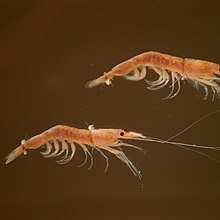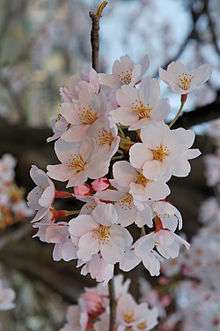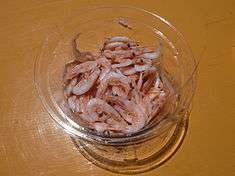Sakura shrimp
Lucensosergia lucens is a species of shrimp popularly known as the sakura shrimp or sakura ebi. The translucent pink shrimp derives its name from sakura, the Japanese word for the cherry blossom. The species grows to about 4–5 cm and lives primarily in Suruga Bay in Shizuoka Prefecture, Japan, where it is caught to be eaten. It is also caught in Taiwan.
| Sakura shrimp | |
|---|---|
 | |
| Scientific classification | |
| Kingdom: | |
| Phylum: | |
| Subphylum: | |
| Class: | |
| Order: | |
| Suborder: | |
| Family: | |
| Genus: | Lucensosergia |
| Species: | L. lucens |
| Binomial name | |
| Lucensosergia lucens (Hansen, 1922) | |
| Synonyms[1][2] | |
| |
Taxonomy
The species name of the sakura shrimp has not been settled. The International Code of Zoological Nomenclature uses the designation Sergia kishinouyei that Nakazawa and Terao gave it in 1915. Researchers tend to use the Sergia lucens, which Danish zoologist Hans Jacob Hansen gave it in 1922, especially since Isabella Gordon published a detailed account of the species in On New Or Imperfectly Known Species of Crustacea Macrura in 1935 using Hansen's designation.[3] Hansen's designation comes from the genus Sergia and the Latin lucentis ("lighting"), likely referring to the sakura shrimp's phosphorescent photophores,[1] which do emit light under certain conditions.

The Japanese name sakura ebi (桜海老) translates as "cherry blossom shrimp"; it is so named because of the pink colour of the dried shrimp.[4]
Description
The sakura shrimp has a lifespan of about 15 months, matures a year after hatching,[5] and dies off 2 or 3 months after spawning.[6]
The adult can grow to 4–5 cm[5][4] and 0.4 g.[7] The body is neartranslucent, but red pigments are present all over the body, so that live specimens appear to be pink (sakura-iro) in color, and this is believed to be the reason the shrimp obtained its Japanese name.[8] These pigments are concentrated in the lateral carapace, around the mouth and mouth appendage, and the tail (uropod and telson).[9]
Most members of Sergestes normally emit light, but for a long time, the sakura shrimp had not been observed to luminesce, despite having photophores.[10][lower-alpha 1] However bioluminescence has been confirmed under laboratory conditions using strobe light or eyestalk-crushing as stimulus.[16] The photophores, which appear as red spots, range in number from 158 to 169 in adults; it numbers fewer in immature specimens and increases as the individual grows.[17]
Three pairs of head appendages are present: the second pair (the antennae) are the longest, and the third (mandible) the shortest.[18] The first set of appendages (antennules) are quite short also, even shorter than the rostrum that are less than half the length of eye stalks.[19]
As for thoractic appendages, there are five pairs of pereiopods present, the second and third pair being chelate, or pincer-ended,[20] as is generally is the case for this entire genus.[21] The fourth and the much shorter fifth pereiopods are flat and consist of 6-segmented,[22] this also being a genus-wide trait.[21]
Distribution
The pelagic[23] Sakura shrimp live in coastal areas, primarily in Suruga Bay in Shizuoka Prefecture, where they form in dense aggregations.[24] Suruga measures about 60 km long and 54 km at its greatest width;[25] at a depth of 2400 m, and with almost no continental shelf, it is the deepest and steepest of Japan's bays.[5] Sakura shrimp remain in depths from 210 to 360m during the daytime.[26]
Sakura shrimp are also found in nearby Sagami and Tokyo Bays, but are not caught there as the populations are too sparse, perhaps because of insufficient depths of the bays.[24] In Taiwan the sakura shrimp is found in the coastal waters of Donggang and on the east coast. Findings have also been recorded in Borneo and New Guinea.[27]
Behaviour
Rather than crawling on the ocean floor as with other species of shrimp, the sakura shrimp spends its life floating in the water. During the day sakura shrimp scatter at a depth of 200–300 m; toward dusk they aggregate at a depth of about 60 m.[5]
Until maturity the ratio of males to females is about equal. Upon reaching maturity males and females separate into groups, and as the females tend to group near the surface close to shore, the sex ratio changes around May to July.[28]
Spawning
Spawning occurs between late May and early November, but primarily in July and August when surface water temperatures are above 20 °C.[29] The ovaries stretch below the heart from the gastric region to the end of the back. As they mature they grow and change colour from yellow to milky blue and finally bluish-green at the time of spawning. The Sakura shrimp spawns an average of 1700–2300 eggs overnight far out in the bays. Distribution concentrates at a depth of about 20–50 m.[29] The eggs average 2.6 mm in circumference. The eggs are not sticky, and with density similar to seawater they remain wafting, typically near the spot they were spawned, spending the course of their life as plankton.[29]
Harvest and consumption
 Boiled Sakura shrimp | |
| Nutritional value per 100g | |
|---|---|
| Energy | 1,305 kJ (312 kcal) |
0.1 g | |
| Dietary fibre | 0 g |
4.0 g | |
| Saturated | 0.59 g |
| Monounsaturated | 0.63 g |
| Polyunsaturated | 0.75 g |
64.9 g | |
| Vitamins | Quantity %DV† |
| Vitamin A equiv. | 0% 0 μg0% 0 μg |
| Thiamine (B1) | 15% 0.17 mg |
| Riboflavin (B2) | 13% 0.15 mg |
| Niacin (B3) | 37% 5.5 mg |
| Pantothenic acid (B5) | 23% 1.16 mg |
| Folate (B9) | 58% 230 μg |
| Vitamin B12 | 458% 11.0 μg |
| Vitamin C | 0% 0 mg |
| Vitamin D | 0% (0) μg |
| Vitamin E | 49% 7.3 mg |
| Vitamin K | 0% (0) μg |
| Minerals | Quantity %DV† |
| Calcium | 200% 2000 mg |
| Copper | 167% 3.34 mg |
| Iron | 25% 3.2 mg |
| Magnesium | 87% 310 mg |
| Phosphorus | 171% 1200 mg |
| Potassium | 26% 1200 mg |
| Sodium | 80% 1200 mg |
| Zinc | 52% 4.9 mg |
| Other constituents | Quantity |
| Water | 19.4 g |
| Colesterol | 700 mg |
| |
| †Percentages are roughly approximated using US recommendations for adults. Source: USDA Nutrient Database | |
The Suruga fishery was established in 1894. During the two fishing periods of March to June and October to December the sakura shrimp are caught by trawling at night.[30]
Annual yields of sakura shrimp average 2000 tons in Suruga Bay and 100 tons in Donggang.[27] In Japan during the summer spawning months Sakura shrimp harvests are prohibited for conservation reasons.[29]
Explanatory notes
References
- Citations
- Vereshchaka, Olesen & Lunina 2014.
- "Sergia lucens". Integrated Taxonomic Information System. Retrieved 2015-03-24.
- Imai, Hanamura & Cheng 2013, pp. 123–124.
- Omori 2002, p. 417.
- Uchida & Baba 2008, p. 176.
- Omori 1970, p. 249: "The adult shrimp gradually die after laying eggs, so the [mature] shrimp nearly disappear by December 親エビは産卵後徐々に死ぬので12月にはほとんど姿を消[す]"
- Shimomura 2012, p. 50.
- Omori 1970, p. 245: "The name sakura in sakura ebi seems to derives from the fact that it has red pigments and 161 photophores scattered across its near-transparent body, causing it the catch to appear cherry-blossom pink (sakura-iro) at a distance サクラエビのサクラという名は、その透明に近い体に赤い色素と161個の発光器が散在するために、遠くからは漁獲物がサクラ色にみえるというところからきたものと思われる."
- Omori 1969, p. 11.
- Shimomura 2012, p. 50, citing Haneda 1985
- Spence Bate (1881). "Prehensilosergia prehensilis". WoRMS. World Register of Marine Species. Retrieved June 15, 2019.
- Komai, Tomoyuki; Komatsu, Hironori (2009), Fujita, Toshihiko (ed.), "Deep-sea Shrimps and Lobsters (Crustacea: Decapoda) from Northern Japan, Collected during the Project..." (PDF), Deep-sea Fauna and Pollutants off Pacific Coast of Northern Japan, National Museum of Nature and Science Monographs, No. 39, p. 511
- Yaldwyn 1957, p. 6.
- Terao, Arata (1916). "Sakura ebi no hakkoki ni tsuite" 櫻蝦の發光器に就て [Notes on the Photophores of Decapod Crustacean, Sergestes prehensilis Bate] (PDF). Dobutsu-gaku Zasshi, the Zoological Magazine. XXVIII (332): 226, 227.CS1 maint: ref=harv (link) (in Japanese)
- Lenz et al. 1997, pp. 175, 182.
- Lenz et al. 1997, p. 175–182.
- Lenz et al. 1997, p. 181–182.
- Omori 1969, p. 27.
- Omori 1969, pp. 40, 35.
- Omori 1969, p. 64.
- Yaldwyn 1957, p. 4.
- Omori 1969, p. 15.
- Lenz et al. 1997, p. 175.
- Uchida & Baba 2008, p. 177.
- Omori & Ohta 1981, p. 107.
- Lenz et al. 1997, p. 183.
- Imai, Hanamura & Cheng 2013, p. 124.
- Kubota 1999b, p. 26.
- Kubota 1999b, p. 25.
- Bishop, Omori & Muranaka 1989, p. 243.
- Bibliography
- Bishop, Gretchen H.; Omori, Makoto; Muranaka, Fumio (1989). "Temporal and spatial variations in the spawning activity of the micronektonic shrimp, Sergia lucens (Hansen) in Suruga Bay, Japan". Journal of the Oceanographical Society of Japan. 45 (4): 243–250. doi:10.1007/BF02124873. ISSN 0029-8131.CS1 maint: ref=harv (link)
- Haneda, Yata (1985). Hakko Seibutsu 発光生物 [Luminous Organisms]. Koseisha-koseikaku.CS1 maint: ref=harv (link) (in Japanese)
- Imai, Hideyuki; Hanamura, Yukio; Cheng, Jin-Hua (2013). "Genetic and morphological differentiation in the Sakura shrimp (Sergia lucens) between Japanese and Taiwanese populations". Contributions to Zoology. 82 (3): 123–130. doi:10.1163/18759866-08203002.CS1 maint: ref=harv (link)
- Kubota, Tadashi (1999). "Sakura-ebi no seikatsu" [The life of Sakura shrimp]. In Ikematsu, Masato (ed.). Suruga-wan kara no okurimono Sakura-ebi 駿河湾からの贈りものサクラエビ [Sakura shrimp: A gift from Suruga Bay]. Kurofune Insatsu. pp. 21–34.
- Omori, Makoto (1969). The Biology of a Sergestid Shrimp, Sergestes lucens Hansen. Ocean Research Institute, University of Tokyo.CS1 maint: ref=harv (link)
- Omori, Makoto (1970). "Kaiyō dōbutsu purankuton no seisan seitai kenkyū no mondai: sakura ebi kenkyū ni kanren shite" 海洋動物プランクトンの生産生態研究の問題さくらえび研究に関連して. Journal of Oceanographic Society of Japan. Ocean Research Institute, University of Tokyo. 26 (4): 242–252. doi:10.1007/BF02799401. ISBN 9780295982397.CS1 maint: ref=harv (link) (in Japanese)
- Omori, Makoto; Ohta, Suguru (1981). "The use of underwater camera in studies of vertical distribution and swimming behaviour of a sergestid shrimp, Sergia lucens" (PDF). Journal of Plankton Research. 3 (1): 107–121. doi:10.1093/plankt/3.1.107.CS1 maint: ref=harv (link)
- Omori, Makoto (2002). "One Hundred Years of Sergestid Shrimp Fishing Industry in Suruga Bay". In Benson, Keith Rodney; Rehbock, Philip F. (eds.). Oceanographic History: The Pacific and Beyond. University of Washington Press. pp. 417–422. ISBN 978-0-295-98239-7.CS1 maint: ref=harv (link)
- Lenz, P.; Hartline, D. K.; Purcell, J.; Macmillian, D., eds. (1997). Zooplankton: Sensory Ecology and Physiology. CRC Press. pp. 175−184. ISBN 9789056990220.CS1 maint: ref=harv (link)
- Shimomura, Osamu (2012). Bioluminescence: Chemical Principles and Methods. World Scientific. p. 50. ISBN 978-981-4366-09-0.CS1 maint: ref=harv (link)
- Uchida, H.; Baba, O. (2008). "Fishery management and the pooling arrangement in the Sakuraebi Fishery in Japan" (PDF). In Townsend, R.; Shotton, R.; Uchida, H. (eds.). Case studies in fisheries self-governance (PDF). FAO. pp. 175–189. ISBN 978-92-5-105897-8.CS1 maint: ref=harv (link)
- Vereshchaka, Alexander L.; Olesen, Jørgen; Lunina, Anastasia A. (2014). Valentine, John F. (ed.). "Global Diversity and Phylogeny of Pelagic Shrimps of the Former Genera Sergestes and Sergia (Crustacea, Dendrobranchiata, Sergestidae), with Definition of Eight New Genera". PLoS ONE. 9 (11): e112057. Bibcode:2014PLoSO...9k2057V. doi:10.1371/journal.pone.0112057. PMC 4237343. PMID 25409458.CS1 maint: ref=harv (link)
- Yaldwyn, J. C. (November 1957). "Deep-Water Crustacea of the Genus Sergestes (Decapoda, Natantia) from Cook Strait, New Zealand". Zoology Publications from Victoria University of Wellington (22): 1–26.